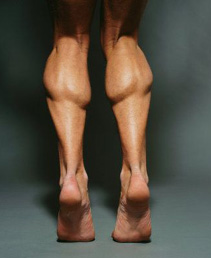
Some people love their calves, while others hate them. Ever see people piling on the weight at the gym (barbells, seated calf press machine, etc.) attempting to build shapely calves? Or maybe you see people performing calf raises on a box with their feet in, straight ahead and out. The question has long been this: is there any real benefit to doing them beyond the neutral or straightforward position to get maximal activation and strength gains?
Why is this important? Well, beyond muscle tone, this question has physiological ramifications with respect to performance and rehabilitation. Consider, for example that as knee flexion angles increase, the medial gastroc becomes increasingly disadvantaged regardless of the ankle position. This suggests inherent functional differences in the muscle architecture and activation patterns of the medial and lateral heads of the gastroc.
In a study just published in the March 2011 Journal of Strength & Conditioning Research, Riemann et al. investigated the impact of all three positions on gastroc activation. They used 20 healthy subjects (10 male and 10 female) with no history of a calf injury and all had prior resistance training experience.

In the study, all subjects performed 1 set of 12 repetitions with 130-135% body mass that included holding a 16-kg Olympic weightlifting bar. They were all barefoot and performed the calf raises with the feet pointed straight ahead, pointing in (hip internal rotation) and feet pointing out (hip external rotation).
It should be noted that subjects were instructed to point their feet inward and outward as far as they were comfortable. The subjects were given 30 seconds to perform the repetitions with a 1/0/1 cadence. So what did the study find?
- No significant difference between medial gastroc (MG) and lateral gastroc (LG) activation in the neutral position
- With the toes pointed in, there was significantly higher LG activation (concentric phase only)
- With the toes pointed out, there was significantly higher MG activation (in concentric and eccentric phases)
The authors point out that concurrent knee and ankle rotation likely affected the activation patterns seen in the study. Some factors to consider before fully adopting this information for all populations are:
- The subjects in this study were all healthy college age people so results may not be transferable to older populations or those with gastroc/soleus injuries or previous injuries
- This study was done barefoot so it is unclear how shod training would alter the results
- The amount of internal and external rotation was not standardized so it is unclear how this would (if at all) impact activation patterns
The takeaway here is that there may be some solid rationale for choosing different angles for calf strengthening depending on what head of the gastroc you want to target. Clearly, calf strengthening is important with respect to running and power sports. Many people forget the gastroc/soleus complex also serves to brake or slow the motion of the foot during the transition from foot flat to mid stance with gait as the lower leg moves forward over the foot, while playing a role in pronation control as well.
It is unclear if these differences lead to altered training adaptations or whether the results apply to other training methods (machines and seated press as examples). Load and the height of the block (3.81 cm here) needs further study as well. For me, I will be curious to see how rehabbing my patients with gastroc/soleus weakness and/or injury is impacted by moving to a more selective strategy such as this since I have not done so in the past. Have thoughts on this?? Let me know.

